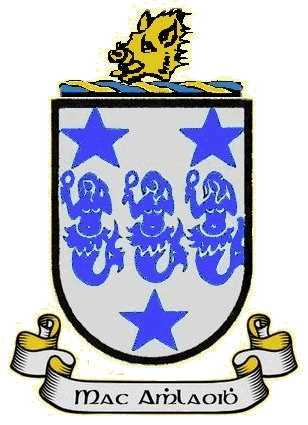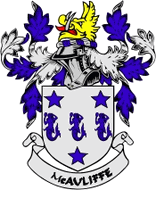In most European countries grants of Arms were usually made to individuals, not to a clan or a family as a whole. Where arms were registered to a chieftain only he or his immediate descendants could rightly lay claim to it. Thus the modern-day practice of claiming a family coat ofarms simply on the basis that one happens to bear the same name is in most cases quite erroneous. In the case of Irish arms, however, many writers have pointed out that grants of arms were viewed more liberally and the arms could be claimed by someone able to show a clan relationship and not necessarily a direct line of descent as was the case with other European grants.
The MacAuliffe Coat of Arms
It is undoubtedly of interest to those who bear the name MacAuliffe (or its variations) to know that there is in existence a MacAuliffe Coat of Arms. This coat of arms was registered in Dublin in 1709, most likely by Dermot MacAuliffe, to provide proof of his status as a noble or gentleman, which seems to have been a necessary qualification for officers in the Spanish army, in which he served.
The coat of arms itself consists of three blue mermaids with combs and mirrors between three blue stars, known as mullets. The crest is a boar's head and the motto reads " Vi et armis - By strength and by arms." The colours are described as argent (silver) for the shield, the mullets and mermaids are fess azure (blue) while the boar's head is couped or (gold).
CONSTITUENT ELEMENTS
The Boar's Head
The boar's head could be a reminder of the days when that animal was hunted in the woods of Clanawley, but it could also have a deeper meaning. The boar appears in the O'Callaghan arms as well, and when we consider that Kanturk or Ceann aire, which means "the Boar's Head," was the centre of MacDonagh MacCarthy country it seems likely that the boar had historical meaning for the MacCarthys. We know that the MacAuliffes and O'Callaghans come from the same MacCarthy stock so it is possible that Dermot, in choosing the boar's head for the crest, was emphasising the MacAuliffe blood relationship with the MacCarthys. Heraldry experts also tell us that the boar's head represented hospitality or signified an hospitable person (from the custom of serving the boar's head in feasts).
The Mermaids
The mermaids may be inspired by Meelin or Mealane of the clan legend. Meelin was looked upon by some as the banshee of the clan; in the popular mind the banshee is often pictured sitting beside a stream combing her hair. The mermaid also represents seafarers or anything to do with the sea. In this case it could imply exile across the sea - as Dermot and others were exiles on the Continent. The mermaid is also said to represent eloquence.
The Mullets
The mullet is said to represent divine quality bestowed by God. It was also used to symbolise a third son.
The Colours
Colours used in heraldry also had significance. In the McAuliffe arms the shield is argent (silver), a colour that represented peace and sincerity; the couped or (gold) in the crest symbolises generosity and elevation oif the mind; the azure (blue) of the mermaids and mullets is said to symbolise truth and loyalty.
The Motto
Mottoes were often recorded with other details when arms were registered and could be displayed as part of the arms. In the case of the McAuliffe Coat of Arms no motto was recorded. There is a motto - 'Vi et armis' - which is often seen with the arms and in some versions appears on the ribbon below the shield. However, since it is not recorded as part of the arms detail it is not correctly a part of the arms, although it might be displayed as part of accompanying ornamentation. The origin of the motto is not clear and it is not certain when it first appeared with the coat of arms.
Depiction
The way in which the McAuliffe Coat of Arms is depicted varies somewhat depending on where it is seen. This is because when arms were registered they were recorded in text form as opposed to an actual picture. The description given for the McAuliffe arms was as follows:
Blazon: Argent three mermaids with combs and mirrors in fess azure between as many mullets of the last.
Crest: A boar's head couped or.
There were often a number of differerent designs available for each of the objects specified so it is possible for one person to come up with one version of the arms while another could produce one with subtle differences, although both could still be accurate in terms of the prescription. Some samples are shown below.
Below are some samples. Accurate colours can not be displayed on computers; gold can be only poorly rendered as yellow; silver is shown as a light grey.

Click image to read the ancient McAuliffe clan legends, in story, and in the verses by Edward Walsh, the Poet of Duhallow

Links to Irish history and culture, genealogy, Irish interest sites
Leave a message or read messages from others seeking clan information, searching for relatives, etc.

The webmaster would appreciate being advised of any broken links you find while viewing any of these pages
Hit counter restarted 10 June 2006


If you haven't already done so, please take a moment or two to sign the Guestbook?






Won't you please take a moment or two to sign the Guestbook?
on the McAuliffe Discussion Forum
Where the webmaster offers opinions on matters affecting the clan


Don't like the music? Turn
it off here or play it again
The openiing tune is 'Carrigfergus'
This and most other midi tunes
on this site were sequenced by Barry Taylor



























Coats of Arms are presented on a shield because that was originally how they were used. The arms were sometimes worn on the armour itself, or sometimes on a coat worn over the armour - thus the name Coat-of-Arms, which over time came to also be applied to the arms displayed on shields

Irish castles worth visiting. Click image to see list


Site designed and maintained by Bob McAuliffe, Greymouth, New Zealand. This page last updated 24 January 2008
An Irish Quote
"If you strike us down now we shall rise again and renew the fight. You cannot conquer Ireland. You cannot extinguish the Irish passion for freedom. If our deed has not been sufficient to win freedom, then our children will win it by a better deed."
Padraig Pearse






So I don't have any yet, but when I do I'll have somewhere to put them.
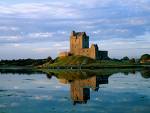


wearing colours emerged. Over time the colours were worn on their protective shields. It then became necessary to make even further distinction because the colours of one knight might be similar to those of another. Thus the practice of combining colours with patterns and designs came about, so that the combination was unique to that individual. Arms offices were set up by kings and rulers to regulate the creation of arms designs and protection against the arms of one knight being used by another.
The arms are presented on a shield because that was originally how they were used. An individual knight could be identified on the battlefield by his shield. The arms were sometimes worn on the armour itself, or sometimes on a coat worn over the armour - thus the name Coat-of-Arms.
As more powerful weapons began to emerge during the 14th and 15th centuries armour was found to be less useful in battle and its use began to decline. However, there was still a need to identify leaders on the battlefield, so that troops could rally to them, so the colours and designs of the arms were sometimes displayed on flags. By this time Coats of Arms were prized for their decoration and fathers proudly handed down the family crest to their sons.
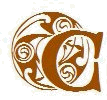
oats of Arms began to emerge at about the time of the Crusades. As knights had a need to protect themselves from more and more deadly weapons they began to cover themselves with body armour. That made it more difficult to identify individuals on the battlefield, so the practice of
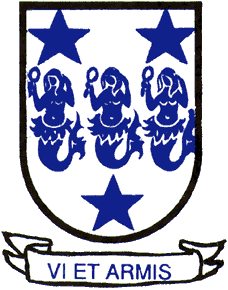
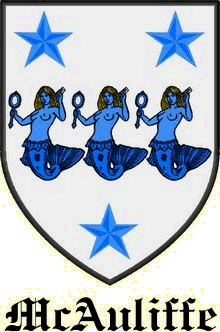
This is a very simple potrayal of the Coat of Arms. However, the colours are not quite accurate. Motto is not properly a part of the arms.
An example from a business that sells representations of arms. Their product comes with more elaboration, including the boar's head crest. To visit their site click here.
This is one I've put together myself with a bit of hybridising, trying to get as much accuracy as possible, given the limitiation of computer colours. It includes the Boar's head crest that is part of the registered arms.
A more elaborate depictionn by a business that sells representations of them. Although somewhat ornate, it is reasonably accurate on colours, although the blue of the shield objects imay be too deep to be described as "azure'. Visit their site here.

What colour is fess azure?
"Of or having a light, purplish shade of blue, like that of a clear and unclouded sky", is how Dictiionary.com describes azure. Fess azure, as used in heraldry, is presumably the shade of azure that is used in a fess, a fess being "a broad horizontal band across the middle of an escutcheon". An escutcheon, in turn, is "a shield or shield-shaped emblem bearing a coat of arms". Nowadays a fess also refers to a broad band across the middle of a flag.
The blue of the mermaids and mullets on the McAuliffe Coat of Arms is presumably, therefore, the shade of azure (blue) that would have been prescribed for a fess (fess azure). On looking at flags of that described colour I find that the sample to the right appears to be a close interptetation.
If anyone has any more information about the McAuliffe Coat of Arms I'd be pleased to hear about it




